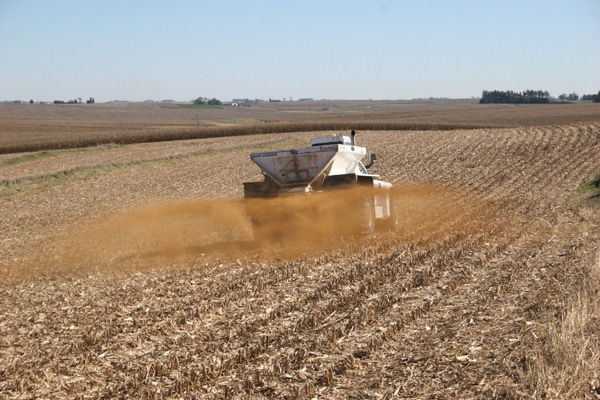
Think differentReview pH and liming sampling practices to ensure both match your current cropping system.Soil test every other year for macro- and micronutrients, and include pH evaluations.Use variable-rate application of lime to match grid or zone samples.Test alternative sources and mesh sizes; compare and adjust.
March 24, 2014

For decades, applying lime to adjust pH has been accepted practice. While a low pH can reduce yields by 40% or more, there’s a surprising shortage of recent research about how lime is tested and graded and what impact it actually has on soil pH and crop yield. These were among the issues raised at a recent conference of lime-industry representatives and USDA-ARS and Iowa State University (ISU) soil researchers. The answers could impact input costs and yields as well as nutrient-management effectiveness.
Particle size impact on reactivity in the soil is one example of current inconsistencies in liming practice. "We have at least 50 particle-size efficiency factors built into the lab process to evaluate limestone in Iowa, but we don't have the research data that were used to determine those factors," says Antonio Mallarino, professor, soils, ISU. "We assume the early Iowa researchers had a basis for them, but we don't have the data to look into it."
Different grading systems
Iowa is not alone. Without data, it is hard to explain why 39 states have different grading systems and 19 offer different definitions of agricultural lime. Even if they were accurate when written, much has changed in cropping systems and inputs, such as anhydrous ammonia and tillage, since most lime-related research was conducted 50 to 60 years ago.
One issue may be the basic test used to evaluate lime sources for their ability to affect pH change. It uses hydrochloric acid to identify the percentage of lime’s calcium carbonate equivalent (CCE). The CCE is used to calculate the ECCE (effective calcium carbonate equivalent), which determines how much of a particular lime product is needed to raise pH to the recommended level.
"Hydrochloric acid may digest large chunks of limestone in the lab, but that doesn't tell us what happens when the organic acids and root exudates hit it," says Andrew Hoiberg, director of research and development, Calcium Products, Gilmore City, Ia. "What impact do particle size and purity of the limestone have on what happens in the soil versus the lab?"
Optimum pH and sampling
Mallarino agrees that particle size and source deserve more study; however, he places an even greater emphasis on simply understanding the optimum pH for different crops. He points out that in Iowa, extensive research was done in the 1960s and 70s, only isolated research had been done from then until 2007. A five-year, statewide on-farm project begun that year, largely confirmed existing recommendations for corn and soybeans. He adds that additional research is needed to verify equations on how much lime is needed to raise pH to the desirable level.
Even soil sampling is up for discussion. Depending on the cropping system, multi-layer testing may be recommended. Lime's resistance to movement within the soil is the main reason that sampling at the 2- to 3-inch depth for pH is commonly recommended. With continuous corn and yearly anhydrous ammonia or manure applications, it is possible to get an acidic layer of pH 5.3 to 5.5 created at the 4- to 6-inch depth.
Add sampling frequency
Mallarino endorses the idea of more frequent sampling, especially in a corn and soybean rotation. While his research has shown little decrease in pH until year four after appropriate liming in most fields, he agrees that more frequent sampling for pH and nutrients in general makes sense. While it won't answer all the questions raised at the conference, it will verify current practices or suggest change.
"As farmers continue to adopt new and better technologies, soil testing more frequently is a good idea because the soil sampling and testing costs have decreased sharply compared with crop, fertilizer and land prices," says Mallarino. "The low additional cost of testing for pH is a good way to ensure the recommended lime amounts are getting pH where it should be."
Over-liming potential
"Most of the root system is in the top layer of the soil, so it is most important to have pH right in that top 6 inches," says Mallarino. "It is easy to over-lime for no-till or pastures if the laboratory calculates the amount to apply for a 6-inch depth, but it moves only 2 to 3 inches as Iowa research indicates."
Over-liming can be as bad as under-liming. pH-sensitive soil microbial and fungal health can affect availability of macro- and micronutrients. Hoiberg thinks there’s huge impact to improve yields and reduce nutrient use. "The right pH range for yield may be different for nutrient availability."
To get the right pH, he suggests more frequent sampling for pH with corresponding and variable-rate lime applications. He notes that nutrients, including those that can acidify the soil, are applied yearly, yet pH is adjusted every four or five years. Hoiberg claims that specialized products, like his company's branded SuperCal 98G pelletized limestone, let growers take a more proactive approach. "Growers can see soil pH improvement in weeks or months instead of years," he says.
Add new product capabilities to existing inconsistencies in modern liming practices, and Hoiberg suggests the time is right for expanded research into lime and liming practices. As part of that effort, Calcium Products is partnering with the Iowa Soybean Association's On-Farm Network to conduct replicated strip trials with SuperCal 98G.
About the Author(s)
You May Also Like



